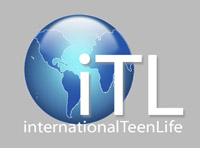[Submission post for the Taking IT Global contest]
What happens when you connect 4 schools across the globe to discover the world as our students see it? The best part about unleashing the chaos – learning, collaborating, investigating, sharing, discovering.
The International Teen Life project I wrote about a few weeks ago has developed into an amazing, authentic, global collaboration. The purpose of the project, as stated on the intro page of the wiki, is…
…to have teenagers from different locations around the globe exchange their thoughts and perceptions of what their lives are like. By viewing, reading, and listening to the perspectives of others from around the globe, we hope that you will gain a greater perception of the similarities and differences of people’s lives around the world. In this project we want to give you an opportunity to explore issues, and work intensely to gain a clearer understanding of concerns that people have in the world.
 Over the past few months, students from Colombia, the United States, Canada and here in Malaysia have collaborated to produce poetic multimedia presentations about global issues that they are concerned about. The topic choice was completely open-ended, and students were able to research, discuss, and determine which global topics where important to them.
Over the past few months, students from Colombia, the United States, Canada and here in Malaysia have collaborated to produce poetic multimedia presentations about global issues that they are concerned about. The topic choice was completely open-ended, and students were able to research, discuss, and determine which global topics where important to them.
The process:
We started by designing a collaborative wikispace where students could start developing ideas that interest them. We posed open-ended questions and let the students make connections to their lives. As part of this process, students were asked to post reflections on their blogs as a way to get the conversations started. This allowed individual students to find like-minded colleagues in each of the partner schools.
Once the partner groups were established, they each created their own group page on the wiki. This became the focal point for notes, discussion, image sharing, and consultation. Many groups started to utilize a variety of web 2.0 tools to add extra features like open chat boxes.
As the topics became more thoroughly developed, we brainstormed ways to effectively complete the end product – a digital video. Each aspect of the process was undertaken by different schools – the students in Colombia filmed the informative video scenes, the students in Malaysia wrote poetry and took poetic images to add an emotional touch, and students in Canada and the US edited together and completed the final product.
The skills:
As a result of this project, our students met the following Digital Age Literacy standards (as defined by NCREL):
- Technological Literacy: Knowledge about what technology is, how it works, what purposes it can serve, and how it can be used efficiently and effectively to achieve specific goals.
- Visual Literacy: The ability to interpret, use, appreciate, and create images and video using both conventional and 21st century media in ways that advance thinking, decision making, communication, and learning.
- Information Literacy: The ability to evaluate information across a range of media; recognize when information is needed; locate, synthesize, and use information effectively; and accomplish these functions using technology, communication networks, and electronic resources.
- Multicultural Literacy: The ability to understand and appreciate the similarities and differences in the customs, values, and beliefs of one’s own culture and the cultures of others.
- Global Awareness: The recognition and understanding of interrelationships among international organizations, nation-states, public and private economic entities, sociocultural groups, and individuals across the globe.
The results:
These students experienced a truly flat world production line as they created their finished project. They collaborated across borders, time zones and cultures. They studied issues affecting the entire world. They utilized and incorporated a wide variety of literacy skills. And they did all of this in eighth grade.
Some of the finished products include (all finished products can be by clicking on the topic link from the planning page):





The South American nation located next to Venezuela and Ecuador is Colombia – – not “Columbia” . . . before we take IT global, let’s try to learnn a bit more about what the globe looks like . . .
Unfortunately (or fortunately, depending on your perspective) it’s my spelling (not my geography) that’s a problem. Good thing we’ve got the two-way communication of web 2.0 to keep me on my toes!